Sara Malacarne
Closing the Gap Between Synthetic and Ground Truth Time Series Distributions via Neural Mapping
Jan 29, 2025
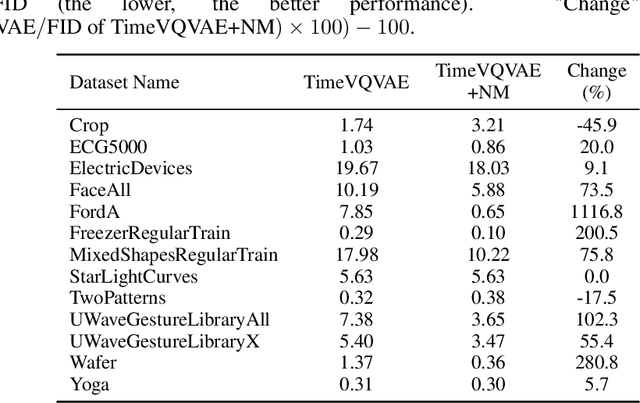
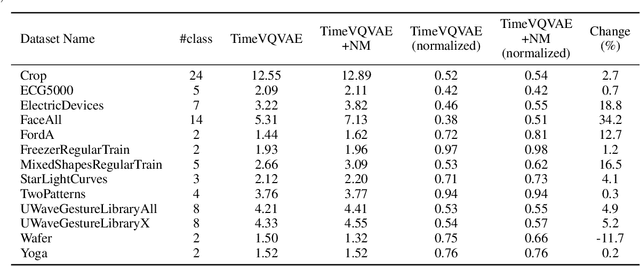
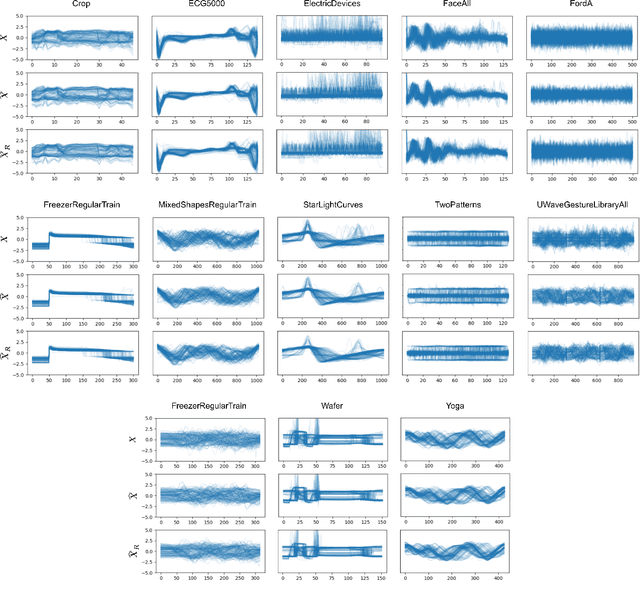
Abstract:In this paper, we introduce Neural Mapper for Vector Quantized Time Series Generator (NM-VQTSG), a novel method aimed at addressing fidelity challenges in vector quantized (VQ) time series generation. VQ-based methods, such as TimeVQVAE, have demonstrated success in generating time series but are hindered by two critical bottlenecks: information loss during compression into discrete latent spaces and deviations in the learned prior distribution from the ground truth distribution. These challenges result in synthetic time series with compromised fidelity and distributional accuracy. To overcome these limitations, NM-VQTSG leverages a U-Net-based neural mapping model to bridge the distributional gap between synthetic and ground truth time series. To be more specific, the model refines synthetic data by addressing artifacts introduced during generation, effectively aligning the distributions of synthetic and real data. Importantly, NM-VQTSG can be used for synthetic time series generated by any VQ-based generative method. We evaluate NM-VQTSG across diverse datasets from the UCR Time Series Classification archive, demonstrating its capability to consistently enhance fidelity in both unconditional and conditional generation tasks. The improvements are evidenced by significant improvements in FID, IS, and conditional FID, additionally backed up by visual inspection in a data space and a latent space. Our findings establish NM-VQTSG as a new method to improve the quality of synthetic time series. Our implementation is available on \url{https://github.com/ML4ITS/TimeVQVAE}.
SiamTST: A Novel Representation Learning Framework for Enhanced Multivariate Time Series Forecasting applied to Telco Networks
Jul 02, 2024



Abstract:We introduce SiamTST, a novel representation learning framework for multivariate time series. SiamTST integrates a Siamese network with attention, channel-independent patching, and normalization techniques to achieve superior performance. Evaluated on a real-world industrial telecommunication dataset, SiamTST demonstrates significant improvements in forecasting accuracy over existing methods. Notably, a simple linear network also shows competitive performance, achieving the second-best results, just behind SiamTST. The code is available at https://github.com/simenkristoff/SiamTST.
Explainable Anomaly Detection using Masked Latent Generative Modeling
Nov 22, 2023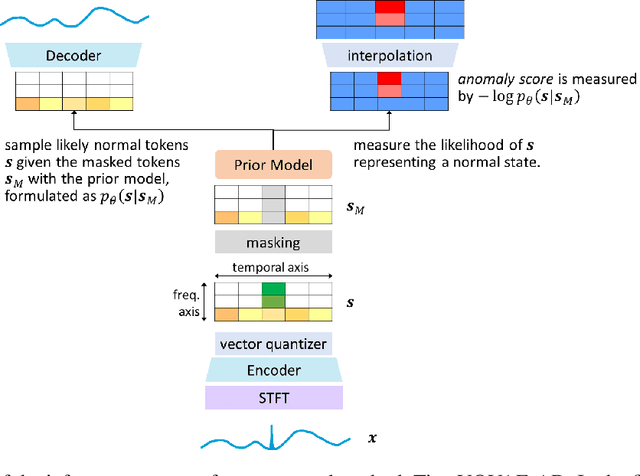
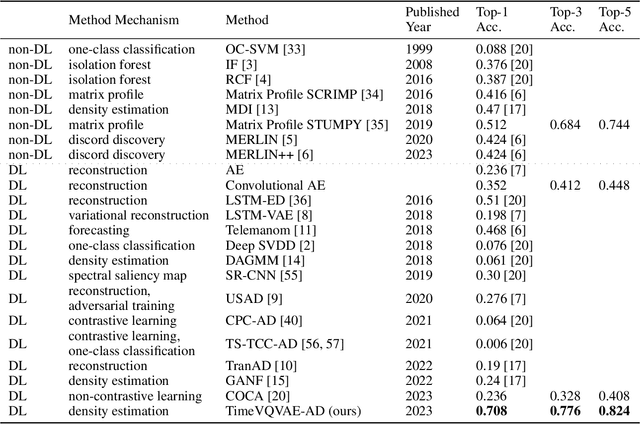


Abstract:We present a novel time series anomaly detection method that achieves excellent detection accuracy while offering a superior level of explainability. Our proposed method, TimeVQVAE-AD, leverages masked generative modeling adapted from the cutting-edge time series generation method known as TimeVQVAE. The prior model is trained on the discrete latent space of a time-frequency domain. Notably, the dimensional semantics of the time-frequency domain are preserved in the latent space, enabling us to compute anomaly scores across different frequency bands, which provides a better insight into the detected anomalies. Additionally, the generative nature of the prior model allows for sampling likely normal states for detected anomalies, enhancing the explainability of the detected anomalies through counterfactuals. Our experimental evaluation on the UCR Time Series Anomaly archive demonstrates that TimeVQVAE-AD significantly surpasses the existing methods in terms of detection accuracy and explainability.
Masked Generative Modeling with Enhanced Sampling Scheme
Sep 14, 2023

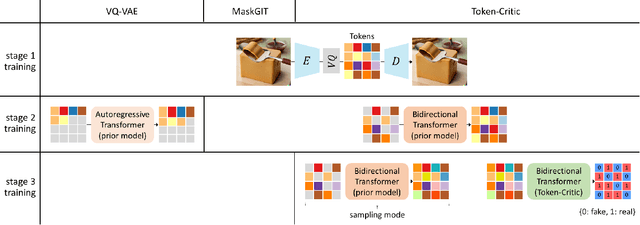
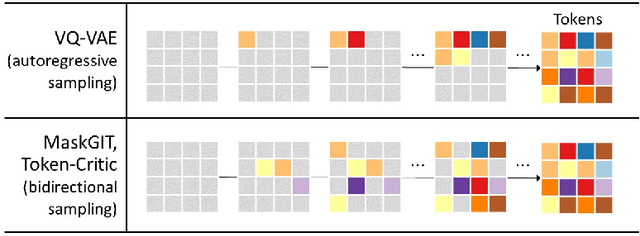
Abstract:This paper presents a novel sampling scheme for masked non-autoregressive generative modeling. We identify the limitations of TimeVQVAE, MaskGIT, and Token-Critic in their sampling processes, and propose Enhanced Sampling Scheme (ESS) to overcome these limitations. ESS explicitly ensures both sample diversity and fidelity, and consists of three stages: Naive Iterative Decoding, Critical Reverse Sampling, and Critical Resampling. ESS starts by sampling a token set using the naive iterative decoding as proposed in MaskGIT, ensuring sample diversity. Then, the token set undergoes the critical reverse sampling, masking tokens leading to unrealistic samples. After that, critical resampling reconstructs masked tokens until the final sampling step is reached to ensure high fidelity. Critical resampling uses confidence scores obtained from a self-Token-Critic to better measure the realism of sampled tokens, while critical reverse sampling uses the structure of the quantized latent vector space to discover unrealistic sample paths. We demonstrate significant performance gains of ESS in both unconditional sampling and class-conditional sampling using all the 128 datasets in the UCR Time Series archive.
Vector Quantized Time Series Generation with a Bidirectional Prior Model
Mar 15, 2023Abstract:Time series generation (TSG) studies have mainly focused on the use of Generative Adversarial Networks (GANs) combined with recurrent neural network (RNN) variants. However, the fundamental limitations and challenges of training GANs still remain. In addition, the RNN-family typically has difficulties with temporal consistency between distant timesteps. Motivated by the successes in the image generation (IMG) domain, we propose TimeVQVAE, the first work, to our knowledge, that uses vector quantization (VQ) techniques to address the TSG problem. Moreover, the priors of the discrete latent spaces are learned with bidirectional transformer models that can better capture global temporal consistency. We also propose VQ modeling in a time-frequency domain, separated into low-frequency (LF) and high-frequency (HF). This allows us to retain important characteristics of the time series and, in turn, generate new synthetic signals that are of better quality, with sharper changes in modularity, than its competing TSG methods. Our experimental evaluation is conducted on all datasets from the UCR archive, using well-established metrics in the IMG literature, such as Fr\'echet inception distance and inception scores. Our implementation on GitHub: \url{https://github.com/ML4ITS/TimeVQVAE}.
 Add to Chrome
Add to Chrome Add to Firefox
Add to Firefox Add to Edge
Add to Edge